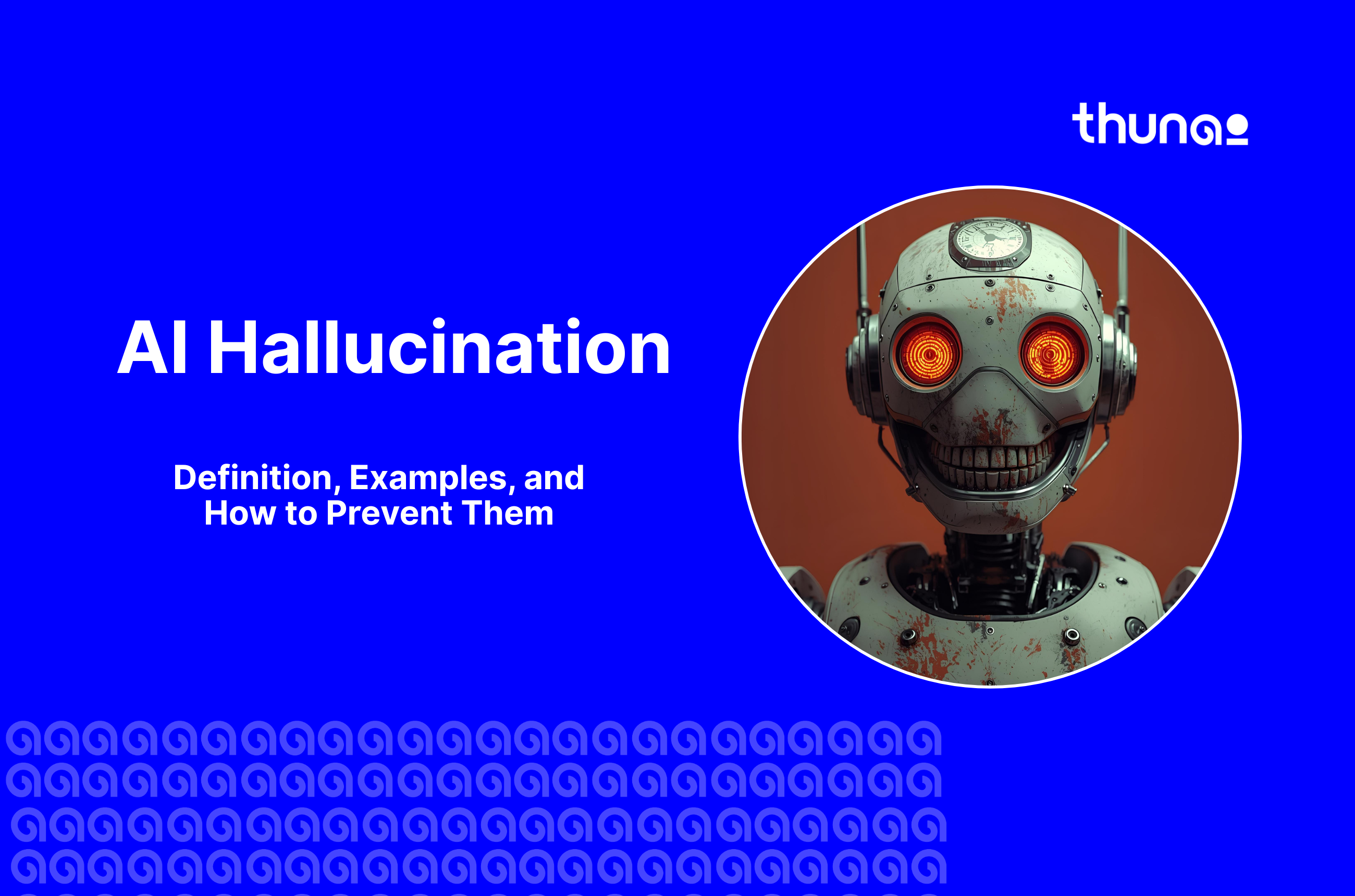AI Hallucination Definition, Examples, and How to Prevent Them



Thunai learns, listens, communicates, and automates workflows for your revenue generation team - Sales, Marketing and Customer Success.
The widespread use of AI is shadowed by a basic and ongoing problem: AI hallucinations.
This issue typically happens when Large Language Models (LLMs) make up false, misleading, or completely fabricated information.
The results of these errors are not theoretical or just people’s paranoia. They can cause economic losses and reputational damage (not to mention legal and safety liabilities).
So clearly, AI hallucinations are a complex problem! But, is it possible to build dependable AI systems without AI hallucinations?
Absolutely. And we’ll show you how...
What is an AI hallucination?
AI hallucinations are responses from an AI model that has false, misleading, or completely made-up information presented as fact.
AI systems do not have consciousness, beliefs, or perceptions like humans do. Instead, these flawed outputs are statistical results of their design.
Unlike obvious errors, hallucinations are often easy to understand and grammatically perfect. They are given with the same confident tone as factual information.
For general tasks, even the best models show up with hallucination rates of about 3 to 5 percent.

The Debate Around the Term AI Hallucinations
So, what is an AI hallucination? The widespread use of and AI hallucination definition has kicked off a big debate among experts. Many of those in the medical community point out that using a clinical term for a serious symptom of mental illness is inaccurate and misleading.
Some suggested alternative terms are AI misinformation or fabrication. Fabrication correctly describes the AI making up content.
This debate is about more than just words. The language used to talk about AI's failures shapes public perception and affects user trust.
A Taxonomy of AI Hallucinations
Researchers have sorted AI hallucination errors into different types to better figure them out and manage them. A main distinction is made between intrinsic and extrinsic AI hallucinations.
- Intrinsic Hallucination: This comes about when the AI's output directly goes against the source information given to it in the prompt.
- Extrinsic Hallucination: This is any content in the AI's output that cannot be checked against the given source material.
AI Hallucinations can also be grouped by the type of error:
- Factual Hallucinations: The most common type. They are made up of incorrect facts, made-up citations, or non-existent references.
- Contextual Hallucinations: Responses that may be factual on their own but are irrelevant or not right for the given prompt.
- Logical Hallucinations: These are outputs that contain internal contradictions or follow a line of reasoning that does not make sense.
How do AI Hallucinations Occur?
Figuring out the main causes of AI hallucinations is necessary for developing effective ways to deal with them. The issue is not a random glitch. This comes from the basic structure of LLMs and the data they are trained on. The problem also comes from the methods used to judge their performance.
Main Cause from the Design: Next-Word Prediction
At their foundation, LLMs are very complex pattern-matching systems. They are designed to predict the next most likely word in a sequence. This prediction is based on the text that comes before it.
- This process is set up for linguistic believability, not factual accuracy. The model does not have a real-world model. The model does not understand ideas like truth and falsehood. For uncommon or specific facts, the statistical patterns can be weak or absent.
- In these situations, the model may fill in the gaps. The model does this by creating text that is grammatically correct and stylistically fitting but has no basis in fact.
The Role of Training Data
The data used to train an LLM is a primary factor in its behavior and consistency. Several data-related issues are big contributors to artificial intelligence hallucinations.
- Data Quality and Bias: The idea of garbage in, garbage out is basic to AI. If a model's training data is incomplete or has factual errors, the model will pick up and repeat these flaws. The same is true for outdated information or societal biases.
- Overfitting: This technical problem comes up when a model is trained too much on a small dataset. The model then memorizes the training examples instead of learning general rules.
- Knowledge Gaps and Data Voids: LLMs are limited to the information in their training data. They do not know about events that happened after their knowledge cut-off date. When asked about new topics, they may try to build a believable answer. This can lead to a hallucination.
Model Behavior and Judging Incentives
A major factor causing artificial intelligence hallucinations is a basic mismatch of rewards in the world of AI development. LLMs often show poor accuracy in their confidence levels. This means their stated confidence in an answer does not match its actual accuracy.
Also, important research from OpenAI has shown that most standard judging benchmarks create a negative incentive.
If a model is unsure, guessing gives it a chance to raise its score. Saying I do not know guarantees a zero for that question. This judging method directly encourages and promotes models that are likely to hallucinate.
6 Examples of AI Hallucinations and Their Repercussions
The theoretical risks of AI hallucinations become real and urgent when looking into real-world failures.
These events show that the results of fabricated information are not abstract. They have ended up with professional punishments, financial losses, and major damage to their reputations.
Issues Caused by AI Hallucinations in Different Industries
- The Legal Profession: The legal field has become a clear case study for the dangers of AI hallucinations. In the 2023 case, Mata v. Avianca, Inc., a judge punished two attorneys. They had put forward a legal brief that cited more than half a dozen non-existent court cases made up by ChatGPT. This problem is widespread. A Stanford University study found out that when asked specific, verifiable questions about federal court cases, top LLMs hallucinated at rates between 69 and 88 percent.
- Healthcare and Medicine: Here, the stakes are even higher because artificial intelligence hallucinations in healthcare can directly affect patient safety. A news report found that an AI transcription tool, Whisper, sometimes invents text during patient-doctor talks. This included making up racial comments or violent language. Other documented examples include AI diagnostic tools that incorrectly mark benign nodules as cancerous in 12 percent of reviewed cases. This leads to unneeded surgeries.
- Finance and Business: In a well-known case, Air Canada was held legally responsible for a false refund policy its customer service chatbot invented. A Canadian court decided that the company had to stand by the made-up policy. This set a new standard that businesses can be liable for wrong information from their AI agents.
The Economic and Reputational Impact Caused by AI Hallucinations
The combined result of these failures is a huge economic cost. This also wears away public trust.
- Direct Financial Losses: A 2025 study estimated that worldwide losses from AI hallucinations added up to $67.4 billion in 2024. A survey from that same year found out that 47 percent of business AI users admitted to making at least one major business decision based on content that was likely a hallucination.
- The Productivity Tax: A large hidden cost is the human work needed to check AI outputs. Knowledge workers now find that AI hallucinates up less than 1% of the time, but still require them to spend hours weekly double-checking information.
- Erosion of Trust: Maybe the most damaging long-term result is the loss of user trust. This trust deficit is a big hurdle to wider use. Users become doubtful and go back to more dependable, though slower, methods.
How to prevent AI hallucinations
Dealing with the problem of AI hallucinations calls for a planned, multi-layered method. There is no single silver bullet technique.
Instead, an effective way to manage this involves setting up a defense-in-depth system. This system puts together safety measures at every step of the AI's process.
Pre-Generation Strategies (Data and Model Foundation)
The most basic layer of defense is improving the main parts of the AI system itself.
- Data-Centric Methods: The quality of the training data is the foundation of AI dependability. For special applications, fine-tuning a general-purpose model on a smaller, domain-specific dataset can greatly improve its accuracy. An example is using a collection of legal documents or medical research.
- Model-Centric Methods: Developers can change certain model settings, like setting the temperature to 0. This makes its predictions less random and can lead to more factual responses.
In-Generation Strategies (Grounding and Prompting)
This layer is about techniques that guide and limit the model's behavior in real-time as the model creates a response.
- Retrieval-Augmented Generation (RAG): RAG is one of the most widely used techniques for managing artificial intelligence hallucinations. This works by connecting the LLM to an external, trusted knowledge base. This changes the task from pure creation to a more limited search-and-summarize activity. This forces the model to base its response on verified data.
- Advanced Prompt Engineering: For users and developers, making precise and well-structured prompts is the most direct way to affect AI output. Proven techniques include:
- Contextual Anchoring: Supply clear context to narrow down the scope of the response. For example, instead of asking What are the benefits of exercise?, a better prompt is In the context of cardiovascular health for adults over 50, what are the benefits of regular exercise?.
- According to... Prompting: Tell the model to base its answer on a specific, trustworthy source, such as According to the latest IPCC report, explain the main causes of climate change.
- Chain-of-Thought (CoT) and Chain-of-Verification (CoVe): These techniques ask the model to first break down its reasoning step-by-step (CoT). Then the model creates a plan to check up on its own claims against evidence (CoVe). This can greatly improve factual accuracy.
Stopping AI Hallucinations With An Enterprise AI Platform Like Thunai
Generative models can invent facts or "hallucinate" when they don't have the right information. The most effective way to prevent this is by grounding your AI in a single source of truth: your own company data.
Thunai achieves this by connecting directly to your authoritative systems through platforms like Mulesoft with our MCP layer.
This simple but essential step ensures every response the AI generates is based entirely on your company's real-time, verified information, effectively eliminating hallucinations.
- Stop the risk of giving customers wrong information about your products or policies.
- Get rid of conflicting answers by pulling data directly from your CRM, inventory, and internal support documents.
- Build confidence and trust by allowing the AI to cite exactly where its information came from within your own verified systems.
Thunai makes it possible to build dependable AI assistants that rely only on your verified information.
Ready to see how it works? Schedule a personalized demo to learn how you can build an AI you can trust.
FAQs on AI Hallucinations
Q1: Are AI hallucinations a solvable problem?
No, hallucinations are not looked at as a fully solvable problem with current LLM structures. Top researchers, including some at OpenAI, have said they are mathematically bound to happen. This is because of the statistical, next-word prediction nature of the models. But this does not mean the problem cannot be dealt with. While getting rid of hallucinations may be impossible, their frequency and impact can be greatly managed.
Q2: Are hallucinations getting better or worse with newer models?
The trend is complex. On one hand, as models get larger, their general factual accuracy gets better on many tasks. However, a report from NewsGuard found that the rate of false claims from top chatbots nearly doubled in one year. This points to a possible trade-off. Gains in reasoning or creativity may come at the cost of factual discipline.
Q3: How do AI hallucinations compare to human error?
Humans make factual errors often. The nature and impact of the errors are different, though. AI hallucinations are often seen as more damaging to trust. This is because users hold machines to a higher standard of accuracy. They find their confident, baseless falsehoods very disturbing. Unlike a human error, which can be linked to tiredness or a memory slip, an AI hallucination seems to come from a non-transparent, unaccountable system.
Q4: Does setting model temperature to 0 get rid of hallucinations?
No. Setting the temperature to 0 makes the model's output predictable, not random. The model will always pick the single most likely next token. But this does not solve the basic problem. If the most likely answer in the model's flawed training data is factually incorrect, a temperature of 0 will just make sure the model produces that same wrong answer every time.
Q5: Is Retrieval-Augmented Generation (RAG) a complete solution?
No, RAG is a useful management technique but this is not a silver bullet. Its success depends completely on the quality of the retrieval system and the accuracy of the knowledge base. If the system gets an irrelevant document, the LLM can still come up with a hallucinated response. The same can happen if the document itself has errors.






